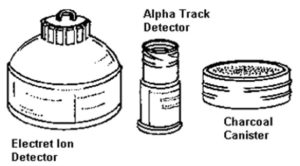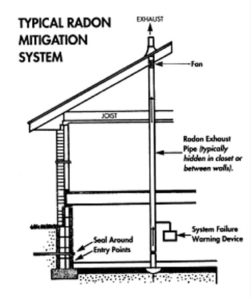Frequently Asked Questions about Radon
Radon is a cancer-causing, radioactive gas.
You can’t see it, smell it or taste it. But it may be a problem in your home.
Radon is estimated to cause many thousands of deaths each year. That’s because when you breathe air containing radon, you can get lung cancer. In fact, the Surgeon General has warned that radon is the second leading cause of lung cancer in the United States today. Only smoking causes more lung cancer deaths. If you smoke and your home has high radon levels, your risk of lung cancer is especially high.
Radon comes from the natural (radioactive) breakdown of uranium in soil, rock and water and gets into the air you breathe. Radon can be found all over the U.S. It can get into any type of building – homes, offices, and schools – and result in a high indoor radon level. But you and your family are most likely to get your greatest exposure at home, where you spend most of your time.
Radon is a radioactive gas. It comes from the natural decay of uranium that is found in nearly all soils. It typically moves up through the ground to the air above and into your home through cracks and other openings in the foundation. Your home traps radon inside, where it can build up. Any home may have a radon problem. This means new and old homes, well-sealed and drafty homes, and homes with or without basements.
Testing is the only way to know if you and your family are at risk from radon. EPA and the Surgeon General recommend testing all homes below the third floor for radon. Nearly 1 out of every 15 homes in the U.S. is estimated to have elevated radon levels. Elevated levels of radon gas have been found in homes in Illinois. Contact IEMA for more information about radon in your area. While radon problems may be more common in some areas, any home may have a problem. The only way to know about your home is to test. Testing is inexpensive and easy – it should only take a few minutes of your time. Millions of Americans have already tested their homes for radon.
Radon can also be a problem in schools and workplaces. Ask IEMA about radon problems in schools, daycare and childcare facilities, and workplaces in your area.
Testing is the only way to know if you and your family are at risk from radon. EPA and the Surgeon General recommend testing all homes below the third floor for radon. Nearly 1 out of every 15 homes in the U.S. is estimated to have elevated radon levels. Elevated levels of radon gas have been found in homes in Illinois. Contact IEMA for more information about radon in your area. While radon problems may be more common in some areas, any home may have a problem. The only way to know about your home is to test. Testing is inexpensive and easy – it should only take a few minutes of your time. Millions of Americans have already tested their homes for radon.
Radon can also be a problem in schools and workplaces. Ask IEMA about radon problems in schools, daycare and childcare facilities, and workplaces in your area.
Testing
There are many kinds of low-cost “do-it-yourself” radon test kits you can get through the mail and in hardware stores and other retail outlets. You may also purchase a “do-it-yourself” radon test kit from Radon Services. If you prefer, or if you are buying or selling a home, you can hire a licensed radon measurement professional to do the testing for you. You should first contact IEMA about obtaining a list of licensed radon measurement professionals. You can also contact a private radon proficiency program for lists of privately certified radon professionals serving your area. For links and information, visit the EPA.
Common short-term test devices are charcoal canisters, alpha track detectors, liquid scintillation detectors, electret ion chambers, and continuous monitors. A short-term testing device remains in the home for two (2) to ninety (90) days, depending on the type of device. Because radon levels tend to vary from day-to-day and season-to-season, a long-term test is more likely than a short-term test to measure the home’s year-round average radon level. If results are needed quickly, however, a short-term test followed by a second short-term test may be used to determine the severity of the radon problem.
Long-term test devices, comparable in cost to devices for short-term testing, remain in the home for more than three (3) months. A long-term test is more likely to indicate the home’s year-round average radon level than a short-term test. Alpha track detectors and electret ion detectors are the most common long-term test devices.
Sometimes short-term tests are less definitive about whether or not your home is above 4 pCi/L. This can happen when your results are close to 4 pCi/L. For example, if the average of your two short-term test results is 4.1 pCi/L, there is about a 50% chance that your year-round average is somewhat below 4 pCi/L. However, EPA believes that any radon exposure carries some risk – no level of radon is safe. Even radon levels below 4 pCi/L pose some risk, and you can reduce your risk of lung cancer by lowering your radon level.

If your living patterns change and you begin occupying a lower level of your home (such as a basement) you should retest your home on that level.
Even if your test result is below 4 pCi/L, you should retest your home every 2 years.
Follow the instructions that come with your test kit. If you are doing a short-term test, close your windows and outside doors and keep them closed as much as possible during the test. Heating and air-conditioning system fans that re-circulate air may be operated. Do not operate fans or other machines which bring in air from outside. Fans that are part of a radon-reduction system or small exhaust fans operating only for short periods of time may run during the test. If you are doing a short-term test lasting just 2 or 3 days, be sure to close your windows and outside doors at least 12 hours before beginning the test, too. You should not conduct short-term tests lasting just 2 or 3 days during unusually severe storms or periods of unusually high winds. The test kit should be placed at the lowest lived-in level of the home (for example, the basement if it is frequently used, otherwise the first floor). It should be put in a room that is used regularly (like a living room, playroom, den or bedroom) but not your kitchen or bathroom. Place the kit at least 20 inches above the floor in a location where it won’t be disturbed – away from drafts, high heat, high humidity, and exterior walls. Leave the kit in place for as long as the package says. Once you’ve finished the test, reseal the package and send it to the lab specified on the package right away for analysis. You should receive your test results within a few weeks.
- If the short-term test result is 4 pCi/L or higher, conduct a follow-up test to confirm the results.
- Follow-up with either a long-term test or a second short-term test.For a better understanding of the home’s year-round average radon level, take a long-term test.If results are needed quickly, take a second short-term test.The higher the initial short-term result, the more certain the homeowner can be to conduct a short-term rather than a long-term follow-up test. If the first short-term test result is several times the action level – for example, about 10 pCi/L or higher – a second short-term test should be taken immediately.
- If the long-term follow-up test result is 4 pCi/L or more, fix the home.If the homeowner followed up with a second short-term test: the higher the short-term results, the more certain the homeowner can be that the home should be fixed. The homeowner should consider fixing the home if the average of the first and second test is 4 pCi/L or higher.
There are several proven methods to reduce radon in your home, but the one primarily used is a vent pipe system and fan, which pulls radon from beneath the house and vents it to the outside. This system, known as a soil suction radon reduction system, does not require major changes to your home. Sealing foundation cracks and other openings makes this kind of system more effective and cost-efficient. Similar systems can also be installed in houses with crawl spaces. Radon contractors can use other methods that may also work in your home. The right system depends on the design of your home and other factors.
The cost of reducing radon in your home depends on how your home was built and the extent of the radon problem. Most homes can be fixed for about the same cost as other common home repairs. The average house costs from about $800 to $1200 for a licensed radon mitigation professional to fix. The cost is much less if a passive system was installed during construction.
Lowering high radon levels requires technical knowledge and special skills. You should use a licensed radon mitigation professional who is trained to fix radon problems. Contact Radon Services for your radon reduction needs.
You should also test your home again after it is fixed to be sure that radon levels have been reduced. Most soil suction radon reduction systems include a monitor that will indicate whether the system is operating properly. In addition, it’s a good idea to retest your home every two years to be sure radon levels remain low.

| The Techniques Work | |
| Simple and inexpensive techniques reduce radon levels on average by 50%. The techniques may also lower levels of other soil gases and decrease moisture problems. |
|
| It’s Cost Effective | |
| Building in the features is much cheaper than fixing a radon problem later |
|
| Save Energy | |
| Radon-reduction techniques are consistent with state-of-the-art energy-efficient construction. When using these techniques, follow the Model Energy Code (or other applicable energy codes) for weatherization, which will result in energy savings and lower utility bills. |
|
| Upgrading is Easy | |
| If high levels of radon are found, a passive radon system can easily be converted to an active radon system for further radon reduction. |